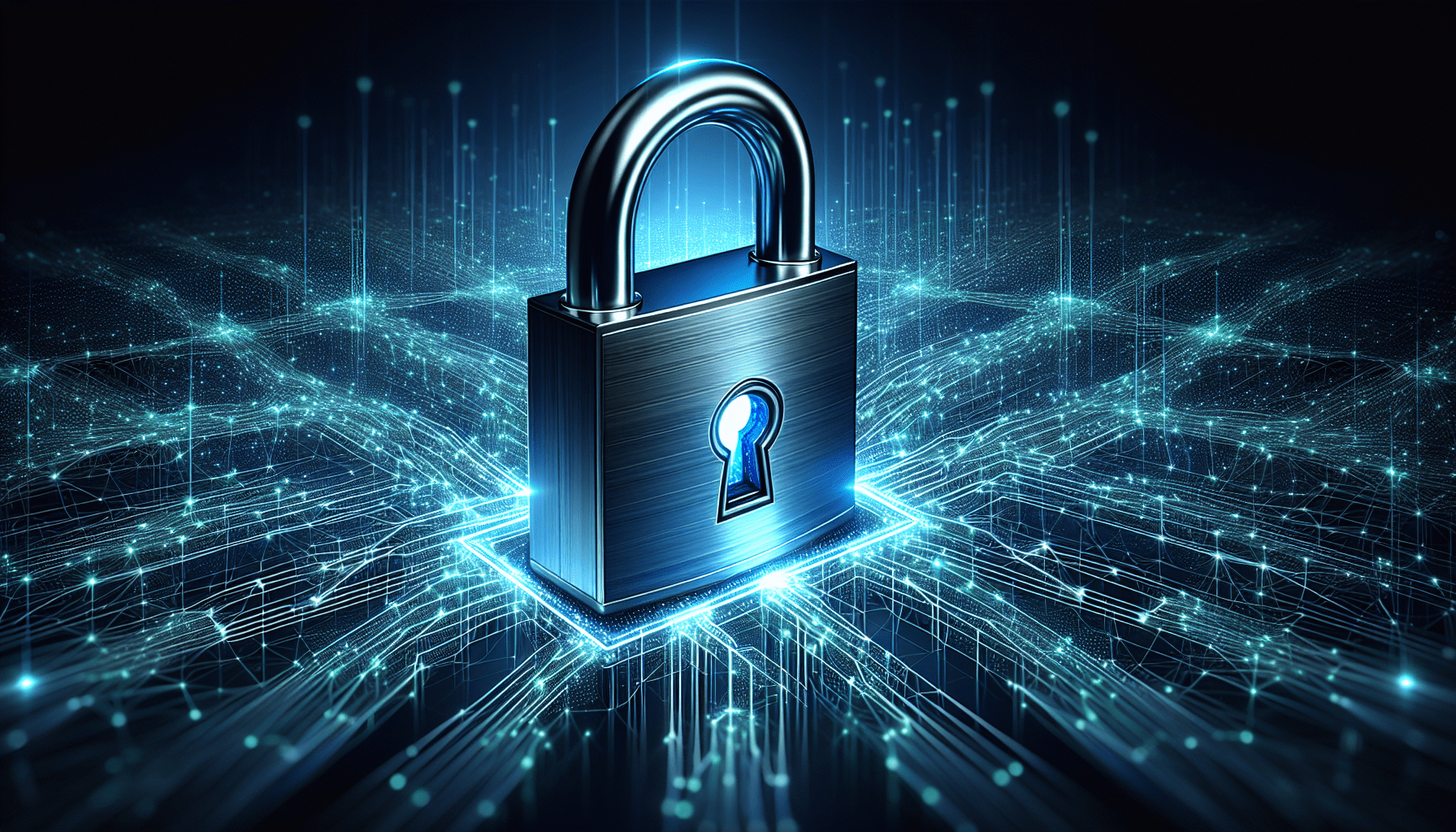So you’ve started your own business, and you’re excited about all the possibilities that lie ahead. But amidst the hustle and bustle of your daily operations, there looms a constant threat: cybersecurity concerns. As an entrepreneur, it’s crucial to understand the importance of safeguarding your business against cyber threats. In this article, we’ll explore some practical strategies that can help you navigate the complex world of cybersecurity and ensure the protection of your valuable business data. From implementing robust security measures to educating your employees, we’ll delve into the key steps you can take to address these concerns head-on and achieve peace of mind in the digital age.
Understanding the Importance of Cybersecurity
In today’s digital age, cybersecurity has become a critical concern for entrepreneurs and businesses of all sizes. Understanding the importance of cybersecurity is crucial in protecting your company’s sensitive information and preventing potentially devastating cyberattacks. By recognizing the risks, identifying vulnerabilities, and assessing potential consequences, you can take proactive measures to safeguard your business and its assets.
Recognizing the Risks
One of the first steps in addressing cybersecurity concerns is recognizing the risks your business faces. Cybercriminals are constantly evolving and utilizing sophisticated techniques to exploit vulnerabilities and gain unauthorized access to sensitive data. From ransomware attacks to phishing scams, the range of threats is extensive. By understanding the various types of cyber threats that exist, you can better prepare for and mitigate potential risks to your business.
Identifying Vulnerabilities
Identifying vulnerabilities within your business’s systems and networks is crucial in preventing cyberattacks. Conducting regular vulnerability assessments allows you to identify weak points in your infrastructure that could potentially be exploited by hackers. This includes evaluating the security of your hardware, software, and network configurations. By addressing these vulnerabilities promptly, you can significantly reduce the likelihood of a successful cyberattack.
Assessing Potential Consequences
Assessing the potential consequences of a cyberattack is essential in understanding the magnitude of the risk your business faces. Consider the financial repercussions, such as the costs associated with data breaches, legal actions, and reputational damage. Evaluate the potential impact on your company’s operations, including downtime and subsequent loss of productivity. By understanding the potential consequences, you can prioritize cybersecurity measures accordingly.
Implementing Strong Password Policies
One of the simplest yet most effective ways to enhance cybersecurity within your business is by implementing strong password policies. Weak or easily guessable passwords can be easily exploited by cybercriminals, granting them unauthorized access to your systems and sensitive data. By enforcing complex password requirements, such as a minimum character length, a combination of uppercase, lowercase letters, numbers, and special characters, you can significantly strengthen your business’s defenses.
Enforcing Complex Password Requirements
Making it mandatory for employees to use complex passwords is an essential step in maintaining strong password security. Educate your employees on the importance of creating unique and complex passwords that are not easily guessable. Encourage the use of password managers, which can generate and securely store strong passwords for each account. Regularly remind employees to update their passwords and avoid reusing them across multiple accounts.
Implementing Multi-Factor Authentication
In addition to complex passwords, implementing multi-factor authentication (MFA) adds an extra layer of security to your business’s systems and accounts. MFA requires users to provide an additional form of verification, such as a fingerprint scan or a one-time passcode generated by a mobile app, in addition to their username and password. This significantly reduces the risk of unauthorized access, even if a password is compromised.
Regularly Updating Passwords
Regularly updating passwords is crucial in maintaining strong password security. Encourage employees to change their passwords at regular intervals, such as every three months. Consider implementing a password expiration policy that automatically prompts employees to update their passwords after a designated period. Additionally, promptly change any default passwords on hardware or software to further enhance security.
Educating Employees on Cybersecurity Best Practices
Employees play a vital role in ensuring cybersecurity within your business. Educating them on cybersecurity best practices is essential in reducing human error and preventing successful cyberattacks. Conduct regular training programs that cover topics such as identifying phishing emails, recognizing suspicious links, and practicing safe internet and email practices.
Conducting Training Programs
Conducting regular cybersecurity training programs for employees is crucial. These programs should cover topics such as phishing scams, social engineering tactics, and the importance of reporting suspicious activities. Provide practical examples and simulations to illustrate potential cybersecurity threats and teach employees how to respond effectively in such situations. By empowering your employees with knowledge, they can act as a strong first line of defense against cyber threats.
Raising Awareness about Common Threats
Raising awareness about common cyber threats is paramount in fostering a cybersecurity-conscious work environment. Regularly communicate with your employees through internal newsletters, emails, or bulletin boards to highlight new or emerging threats. Share real-life examples of cyberattacks to educate employees on the potential consequences of failing to follow cybersecurity best practices. Encourage open communication and reporting of any suspicious activities or incidents to ensure quick and effective responses.
Teaching Safe Internet and Email Practices
Internet and email practices can greatly impact your business’s cybersecurity. Teach employees safe internet browsing habits, such as avoiding suspicious websites, refraining from downloading files from untrusted sources, and using caution when clicking on links. Emphasize the importance of verifying the authenticity of email senders, especially when dealing with sensitive information or financial transactions. Implement spam filters to reduce the risk of employees opening malicious emails.
Securing Networks and Systems
Securing your business’s networks and systems is crucial in preventing unauthorized access and potential data breaches. By implementing firewalls and antivirus software, encrypting sensitive data, and regularly updating and patching software, you can significantly enhance your business’s overall cybersecurity posture.
Installing Firewalls and Antivirus Software
Firewalls act as a barrier between your internal network and the external world, monitoring and controlling incoming and outgoing network traffic. Implement robust firewalls that can detect and block malicious traffic, ensuring that only authorized communication is allowed. Additionally, install antivirus software on all devices to detect and remove any malware that may pose a threat.
Implementing Encryption Measures
Encrypting sensitive data is a vital step in protecting it from unauthorized access. Utilize strong encryption algorithms to convert sensitive information into unreadable ciphertext. Implement encryption measures not only for data stored on devices but also for data transmitted over networks or stored in the cloud. By incorporating encryption, even if data is intercepted, it will remain unreadable without the encryption key.
Regularly Updating and Patching Software
Regularly updating and patching software is crucial in addressing known vulnerabilities and preventing cyberattacks. Cybercriminals often target outdated software with known vulnerabilities that can be easily exploited. Utilize automatic software updates whenever possible to ensure that your systems and applications are updated with the latest security patches. Establish a system for patch management to prioritize and promptly apply critical updates.
Adopting Safe Web Browsing Habits
Safe web browsing habits can greatly minimize the risk of falling victim to cyber threats. By avoiding suspicious websites, clicking on links with caution, and enabling pop-up blockers, you can significantly reduce the likelihood of being exposed to malware, phishing attempts, or other malicious activities.
Avoiding Suspicious Websites
Encourage employees to exercise caution when accessing websites and avoid visiting suspicious or untrustworthy sites. Teach them to look for HTTPS encryption, verify website certificates, and be cautious of websites that appear unprofessional or contain unexpected pop-ups. Implement web filters to block access to known malicious websites and reduce the risk of employees accidentally visiting them.
Clicking on Links with Caution
Clicking on malicious links is one of the most common ways cybercriminals gain unauthorized access to sensitive information. Instruct employees to hover over links before clicking on them to verify that the URL matches the displayed text. Teach them to avoid clicking on links from unknown or suspicious sources, particularly in emails, instant messages, or social media platforms. Implement email filters to minimize the risk of employees receiving phishing emails containing malicious links.
Enabling Pop-Up Blockers
Pop-up blockers prevent unwanted pop-up windows from appearing while browsing the internet. Many pop-ups contain malicious content or attempt to trick users into revealing sensitive information. Enable pop-up blockers on all devices to reduce the risk of employees inadvertently interacting with harmful pop-ups. Educate employees on how to enable and disable pop-up blockers in different browsers and how to whitelist trusted websites when necessary.
Backing Up Data Regularly
Data loss can have severe consequences for your business. Regularly backing up your data is essential in ensuring that you can recover from any potential cyber incidents, such as ransomware attacks or hardware failures. By implementing regular data backup procedures, storing backups in secure locations, and regularly testing data restoration processes, you can minimize the impact of data loss on your business.
Implementing Regular Data Backup Procedures
Implement a regular data backup schedule to ensure that your critical data is always protected. Decide on the frequency of backups based on the volume and sensitivity of your data. Consider using automated backup solutions that can securely and efficiently back up your data without interrupting normal operations. Regularly review and update your backup procedures to accommodate any changes in your business’s data landscape.
Storing Backups in Secure Locations
Ensure that your backups are stored in secure locations to prevent unauthorized access and potential data breaches. Implement secure backup storage solutions that offer encryption and access controls. Consider storing backups both on-premises and in the cloud to provide redundancy and ensure the availability and integrity of your data. Regularly audit your backup storage systems to verify their security and functionality.
Testing Data Restoration Processes
Backing up data without testing the restoration process is a common mistake that can undermine your business’s ability to recover from an incident. Regularly test the restoration process by simulating different scenarios and verifying the integrity and completeness of restored data. Ensure that your employees are familiar with the restoration process and can confidently recover data when needed. Periodically review and update your data restoration procedures to address any identified weaknesses.
Monitoring and Responding to Cyber Threats
Proactively monitoring and responding to cyber threats is essential in minimizing potential damage and effectively neutralizing attacks. By implementing intrusion detection systems, monitoring network traffic and logs, and creating incident response plans, you can detect and respond to cyber threats in a timely and efficient manner.
Implementing Intrusion Detection Systems
Intrusion detection systems (IDS) monitor network traffic and identify potential security breaches or unauthorized access attempts. Implement IDS within your business’s network to detect and alert you to any suspicious activities. Configure IDS to trigger alarm notifications for potential security incidents, enabling your IT team to investigate and respond promptly. Regularly review IDS logs and adjust detection rules to stay up-to-date with emerging threats.
Monitoring Network Traffic and Logs
Monitoring network traffic and logs provides vital insights into the security of your business’s systems. Analyze network traffic patterns to detect anomalies that may indicate a potential security breach. Log and monitor system events, including login attempts, file access, and system changes, to identify any suspicious activities. Implement a centralized logging system to aggregate logs from various sources, enabling efficient analysis and detection of potential threats.
Creating Incident Response Plans
Creating well-defined incident response plans is crucial in effectively managing and responding to cybersecurity incidents. Develop detailed procedures that outline the steps to be taken in the event of a security breach, including incident assessment, containment, eradication, and recovery. Clearly define the roles and responsibilities of your incident response team, detailing their response actions and communication protocols. Regularly test and update your incident response plans to ensure their effectiveness and alignment with evolving threats.
Implementing Access Controls
Implementing access controls within your business’s systems and networks is essential in preventing unauthorized access and minimizing the risk of data breaches. By granting minimal privileges to users, controlling physical access to servers, and implementing role-based access controls, you can significantly enhance the security of your business’s sensitive information.
Granting Minimal Privileges to Users
Granting users minimal privileges based on their job roles or responsibilities is crucial in minimizing the risk of unauthorized access. Implement a principle of least privilege, granting users only the permissions necessary to perform their specific tasks. Regularly review and update user privileges to ensure that access rights remain relevant and aligned with job responsibilities. Implement strong authentication mechanisms, such as two-factor authentication, for privileged user accounts.
Controlling Physical Access to Servers
Physical security measures are just as important as digital security measures in protecting sensitive information. Implement strict access controls to server rooms or data centers, restricting entry to authorized personnel only. Utilize proximity card readers, biometric authentication systems, or surveillance cameras to monitor and control physical access. Regularly audit and review physical access logs to detect any unauthorized attempts or suspicious activities.
Implementing Role-Based Access Controls
Role-based access controls (RBAC) provide a structured approach to managing user permissions. Define different roles within your organization based on job responsibilities and assign the relevant permissions to each role. Assigning permissions based on predefined roles simplifies access management and avoids granting excessive privileges to individual users. Regularly review and update RBAC policies to reflect changes in job roles or access requirements.
Regularly Updating and Patching Software
Regularly updating and patching software is a fundamental practice in addressing known vulnerabilities and ensuring the security of your business’s systems and applications. By utilizing automatic software updates, installing security patches, and maintaining a system for patch management, you can significantly reduce the risk of falling victim to cyberattacks.
Utilizing Automatic Software Updates
Utilize automatic software update features whenever possible to ensure that your systems and applications are consistently updated with the latest security patches. Automatic updates streamline the patching process, reducing the risk of human error and ensuring that critical updates are promptly applied. Regularly review the update settings for all software and devices to confirm that automatic updates are enabled and functioning correctly.
Installing Security Patches
Stay vigilant in installing security patches released by software vendors to address known vulnerabilities. Regularly check for available updates and promptly install them to ensure that your systems are protected against the latest threats. Establish a patch management process that includes procedures for identifying, testing, and deploying patches to minimize disruptions to business operations. Utilize vulnerability scanners to identify any missed patches and ensure comprehensive coverage.
Maintaining a System for Patch Management
Maintaining a system for patch management helps ensure that vulnerabilities are promptly addressed across all systems and applications. Implement a centralized patch management system that allows you to monitor and control the patching process for all devices and software. Establish a patch management team responsible for assessing the criticality and urgency of patches, testing them in a controlled environment, and deploying them efficiently without disrupting business functions.
Engaging External Cybersecurity Experts
In some cases, seeking assistance from external cybersecurity experts can provide specialized knowledge and resources to enhance your business’s cybersecurity efforts. Conducting regular security audits, seeking professional guidance, and contracting managed security services can offer valuable insights and support in mitigating cyber risks.
Conducting Regular Security Audits
Regular security audits conducted by external cybersecurity experts can help identify vulnerabilities and weaknesses in your business’s security posture. These audits analyze your systems, networks, and processes to assess their compliance with best practices and industry standards. Based on the audit findings, you can prioritize and implement necessary security improvements to address identified weaknesses and strengthen your overall cybersecurity framework.
Seeking Professional Guidance
Seeking professional guidance from cybersecurity experts can provide valuable insights and recommendations tailored to your business’s specific needs. Cybersecurity consultants can assess your current cybersecurity measures, identify gaps, and propose effective solutions to mitigate risks. Engaging with professionals who specialize in your industry can offer industry-specific knowledge and ensure that your cybersecurity efforts align with relevant regulations and compliance requirements.
Contracting Managed Security Services
Contracting managed security services can provide your business with ongoing cybersecurity support and expertise. Managed security service providers (MSSPs) offer a range of services, including round-the-clock monitoring, incident response, vulnerability management, and threat intelligence. By outsourcing your cybersecurity needs to MSSPs, you can benefit from their advanced tools, technologies, and skilled personnel, without the need for significant investments in infrastructure and resources.
In conclusion, addressing cybersecurity concerns in your business requires a comprehensive and proactive approach. By understanding the importance of cybersecurity, implementing strong password policies, educating employees on best practices, securing networks and systems, adopting safe web browsing habits, backing up data regularly, monitoring and responding to cyber threats, implementing access controls, regularly updating and patching software, and engaging external cybersecurity experts, you can significantly enhance your business’s cybersecurity posture. Prioritizing cybersecurity not only protects your sensitive information and assets but also safeguards your reputation and provides peace of mind to your customers and stakeholders.





